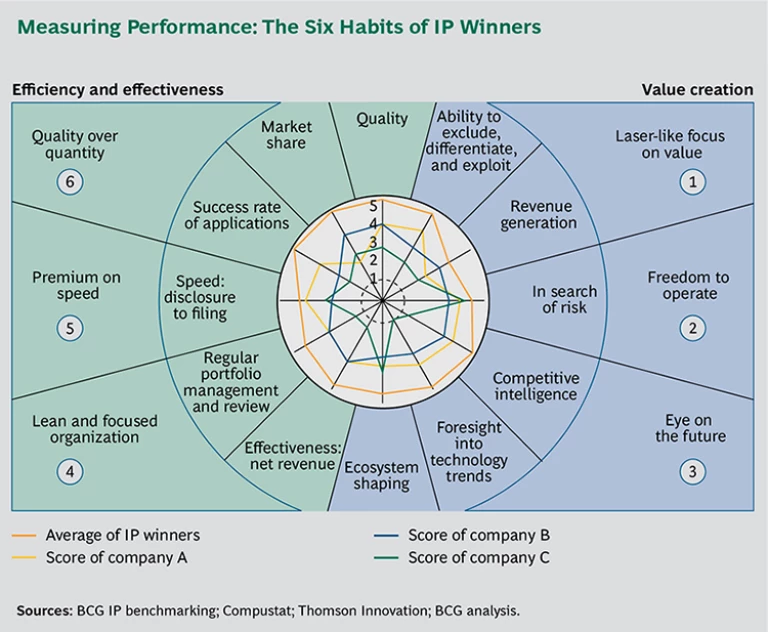Innovation both depends on and generates intellectual property. And it’s not just a tech thing. Smart companies across all industries increasingly use IP as both an offensive and a defensive competitive weapon. Hundreds of millions—if not billions—of dollars can be at stake; organizations need to up their IP game to protect that investment. In our experience, IP winners take a strategic and proactive approach that embraces six broad practices, and each practice, in turn, is associated with critical subcapabilities. These practices and capabilities come together in a framework we call the “IP wheel.” (See the exhibit below.)
The Most Innovative Companies 2013
In general, to ensure the smoothest and swiftest ride into the future, organizations should aspire to be well-rounded in all six practices.
Laser-Like Focus on Value. IP winners put a price on the value generated by their innovations. They quantify all aspects of their IP—licensing revenues, the premiums that innovations build into products, and the competitive advantages those innovations provide in the market, including the ability to exclude others. Many IP leaders build dedicated businesses around licensing. They also actively seek out third-party assets that will strengthen and round out licensing portfolios.
Freedom to Operate. In an increasingly complex world, innovative new products, designs, and technologies often require access to a range of IP. Few if any companies own all the IP they need in order to innovate and grow. Strong IP companies constantly analyze their own IP, as well as the portfolios of competitors and patent-assertion entities (often referred to as “patent trolls”), with the aim of ensuring affordable access to the IP they need now and in the future. They protect their freedom to operate by managing their own portfolios strategically. They buy important IP assets in the market and enter into partnerships that provide access to essential technologies. They also amass their own IP arsenals, signaling to competitors a willingness to act aggressively to protect their IP turf.
Eye on the Future. IP winners follow the moves of competitors and anticipate the direction of technological and innovation trends. Their analyses feed their corporate innovation agenda, and they make sure that their IP strategies and portfolios are designed to support that agenda.
Lean and Focused Organization. Top IP players organize their IP-related functions to generate value. They understand the capabilities that they need, and they build lean, expert teams that can cover their costs many times over through licensing, risk mitigation, price premiums, and other yardsticks. The IP function is viewed as a strategic partner of the business units, not of an administrative or staff unit. Senior management is engaged and pays attention to the right issues. Top executives actively participate in IP and innovation reviews to ensure that innovation activities are aligned with strategy.
Premium on Speed. IP winners are quick to file patent applications when they have inventions worth protecting. They often file applications in multiple nations in order to achieve coverage in key markets. The emphasis on speed has become especially important in the U.S., where, starting in March 2013, patents are being awarded on the basis of first-to-file rather than first-to-invent, harmonizing U.S. patent policy with that of the rest of the world. IP leaders also actively shepherd their patents through the application process.
Quality over Quantity. Companies that manage their IP assets effectively are more successful than their competitors at winning approval for their applications, securing patents more than 60 percent of the time. They control a disproportionate share of the IP within their industries, measured not necessarily by raw numbers of applications and claims but by breadth and depth of coverage. A recent trend among IP leaders appears to be reducing the number of patent applications and focusing instead on the more important ones, emphasizing quality over quantity.






